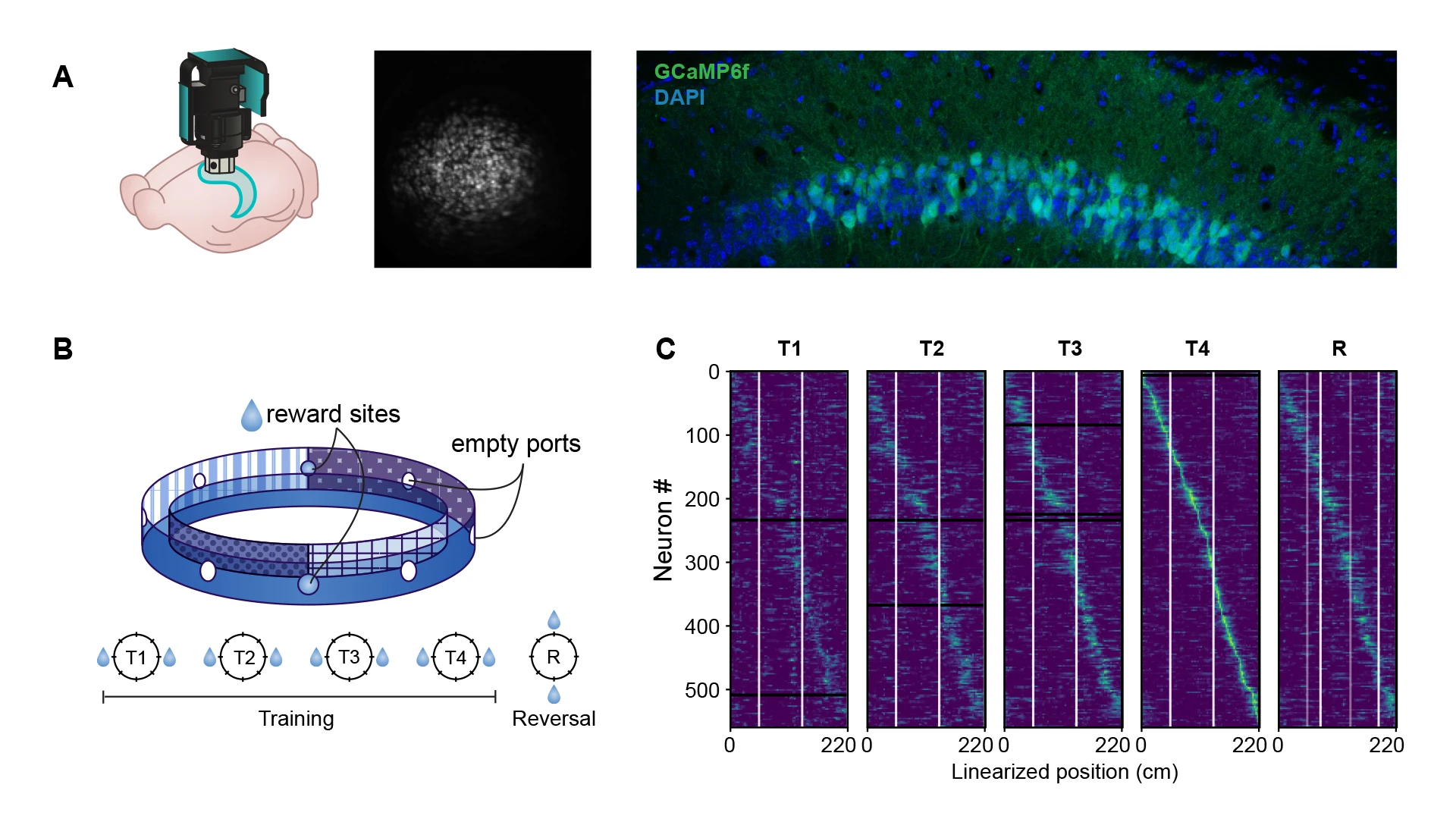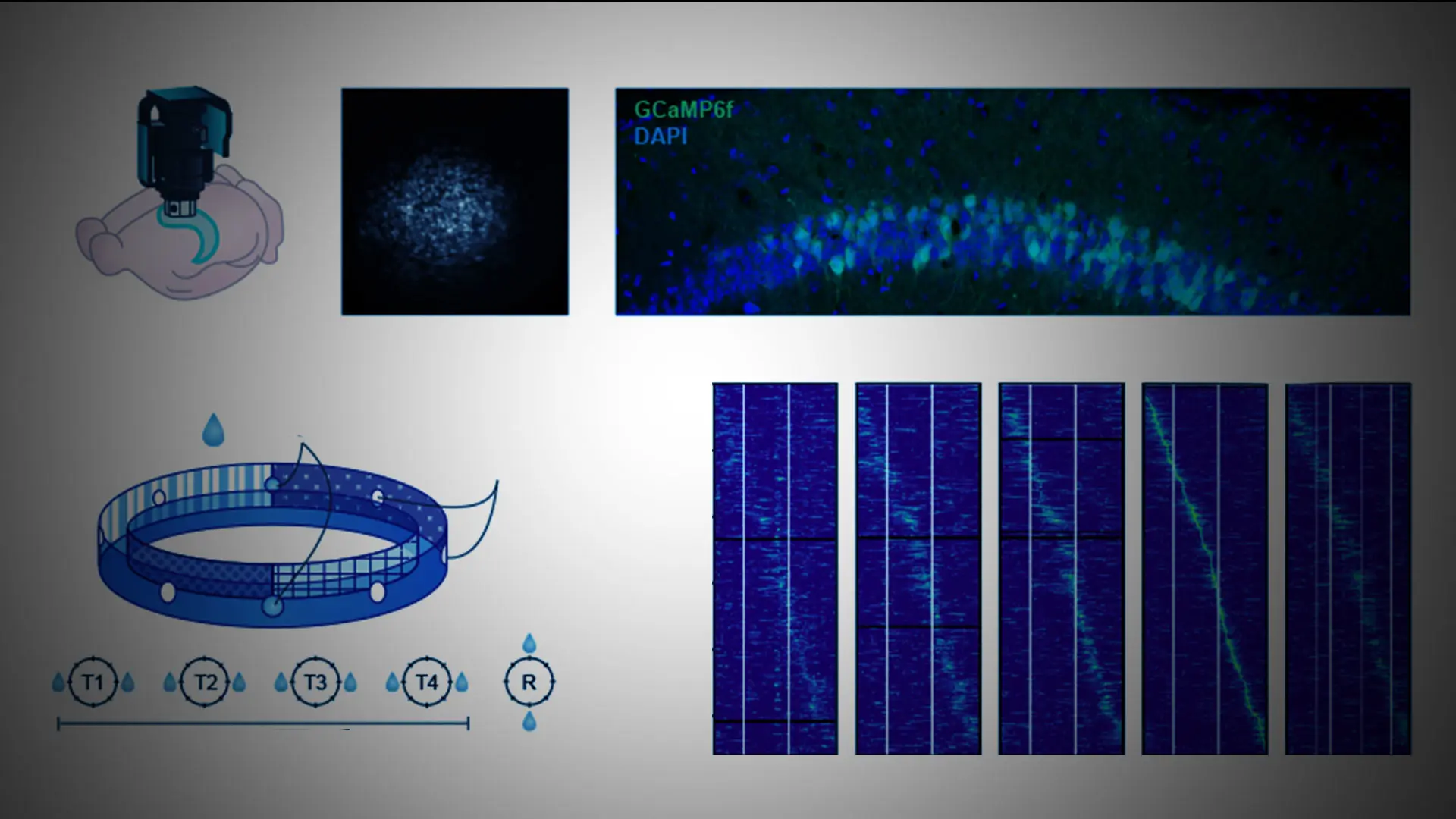Highlighting the contributions made to the field by Denise Cai, PhD; Xiaoting Wu, PhD; Herbert Zheng Wu, PhD; and Tristan Shuman, PhD
New imaging technologies unlock mechanisms of memory
One of the central questions of memory research has long been focused on how memories are stably stored in the brain. Researchers have found that memories are encoded in subsets of neurons called “neural ensembles,” and that many of those same neurons are reactivated during recall of the memory. These neural ensembles are historically thought to underlie the stable representation of memories in the brain. However, with new imaging tools, such as in vivo calcium imaging with miniature microscopes (“Miniscopes”), we can record the activity of thousands of neurons in an individual animal’s brain over the course of weeks and months.

Figure 1. Technologies such as Miniscope calcium imaging allow real-time observation of neuronal ensembles (A) while mice perform behavioral tasks (B), tracking the encoding of spatial memory across sessions (C).
This allows us to ask new questions about how memories are maintained in the brain. Using this approach, we are now discovering that neural ensembles are less stable and more dynamic than previously thought, and that this allows memories to be updated with new information. In the aging brain, rodent models show reduced flexibility in learning new information, and this is accompanied by less flexibility in their neural representations. This novel insight into memory deficits that occur with aging was only made possible by use of this new recording technology that allowed us to track large ensembles of neurons over many weeks and follow their changing dynamics throughout the learning and memory process.
New circuit-specific manipulations identify neural circuits of social behavior
Mechanistic understanding of social behaviors arose predominantly from studies of innate reproductive behaviors. As a result, a great deal of information is still unknown about the more intricate forms of social behavior (such as trust, helping, empathy), which are impacted across a range of neuropsychiatric syndromes from autism spectrum disorders (ASDs), to schizophrenia, to depression.
For example, mouse models allow for understanding ASD-associated behavioral and cognitive deficits through cellular-level dissection of brain circuits. New behavioral paradigms are isolating the specific decision-making processes that underlie social behavior, and the precise manipulation of isolated circuits (for example, through optogenetic or chemogenetic approaches) has revealed novel functions of neurotransmitters and their circuits in social cognition. Together, these innovations are driving exciting new developments in the study of social behavior and how they relate to neuropsychiatric illnesses.
New closed-loop systems allow analysis of the timing of neural activity in behavioral responses
Neural circuits perform incredible computations with exquisite temporal precision, which aligns the activity of different neurons within milliseconds of each other. This timing has been presumed to underlie normal brain processing and is disrupted across mouse models of many neurological and psychiatric disorders, including epilepsy, Alzheimer’s disease, and ASDs. There has previously been no way to directly test how the timing of neural activity impacts behavior, but recent developments in closed-loop manipulations are now allowing us to examine how the precise timing of neural activity controls cognition.
A closed-loop system automatically adjusts neural activity to maintain a given outcome measure. Using optogenetics and real-time processing algorithms, we can now activate and inhibit neurons with millisecond precision and directly manipulate the timing of neural activity relative to ongoing brain processes.
Implementing these new closed-loop approaches allows us to explore new treatments by manipulating the timing of neural activity within the context of complex behaviors. By combining new technologies with innovative experimental approaches, researchers are poised to make groundbreaking discoveries that will have a lasting impact on human health.
Featured

Denise Cai, PhD
Associate Professor of Neuroscience, Icahn School of Medicine at Mount Sinai

Xiaoting Wu, PhD
Assistant Professor of Neuroscience, Icahn School of Medicine at Mount Sinai

Herbert Zheng Wu, PhD
Assistant Professor of Neuroscience, Icahn School of Medicine at Mount Sinai

Tristan Shuman, PhD
Assistant Professor of Neuroscience, Icahn School of Medicine at Mount Sinai
